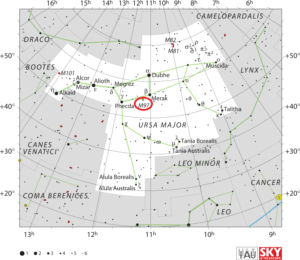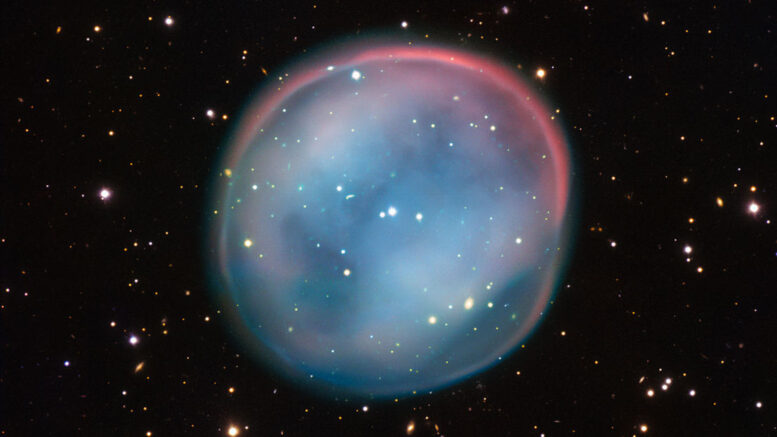Messier 97, also known as the Owl Nebula, is a famous planetary nebula located in Ursa Major constellation. It was named the Owl Nebula because of its appearance in larger telescopes, which reveal two dark patches that look like the eyes of an owl. These were first sketched by William Parsons, 3rd Earl of Rosse in 1848. Messier 97 is one of only four planetary nebulae listed in the Messier Catalogue.
Like most planetary nebulae, M97 appears brighter visually than photographically because it emits most of its light in one green spectral line.
Another Messier object, the barred spiral galaxy M108, can be seen 50 arc minutes northwest of the Owl Nebula. The two objects appear in the same wide field view. The best time of year to observe M97 is during the spring, but observers north of latitude 35N can see the nebula throughout the year, as it never sets below the horizon in for them.
| Description | |
| Visible From Pacific Northwest | December to June |
| Best Time To Observe | March, April, and May |
| Minimum Size Of Viewing Device | 20×80 binocular |
| Object Type | Planetary Nebula |
| Designations | Messier 97, M97, NGC 3587, Owl Nebula, VV 59, VV 107, ARO 25, LJHY 9, AG82 135, BWE 1111+5517, CSI+55-11119, GB6 B1111+5517, EUVE J1114+55.0, GCRV 6897, IRAS 11119+5517, 2MASS J11144772+5501085, PK 148+57 1, PN G148.4+57.0, SDSS J111447.71+550108.4, SDSS J111447.70+550108.7, WD 1111+552 |
| Right Ascension | 11h 14m 47.734s |
| Declination | +55°01’08.50” |
| Constellation | Ursa Major |
| Age | 8,000 years |
| Apparent magnitude | +9.9 |
| Apparent dimensions | 3′.4 x 3′.3 |
| Object Radius | .91 light years |
| Distance From Earth | 2,030 light years |
History
The Owl Nebula was discovered by French astronomer Pierre Méchain on February 16, 1781. Méchain reported the discovery to his friend and colleague Charles Messier, who added the nebula to his catalogue.
In his notes about M97, Messier also mentions two other objects that he observed at the same time. He determined the positions for both objects, but did not include them in his catalogue. From his descriptions, it is clear that he observed the objects we now know as Messier 108 and Messier 109. The two galaxies were given Messier names by the American astronomer Owen Gingerich in 1953.
William Herschel described M97 as a “very bright, round nebula of about 3′ in diameter,” adding that “it is nearly of equal light throughout, with an ill-defined margin of no great extent.”
Admiral William Henry Smyth was the first to classify M97 as a planetary nebula.
John Herschel catalogued M97 as h 838 in 1831 and later added it to the General Catalogue as GC 2343.
William Huggins studied the spectrum of M97 and recognised the nature of the object as a gaseous nebula.
Locating M97 In The Sky
The Owl Nebula can be found about 2.5 degrees southeast of Merak, Beta Ursae Majoris. The star marks the southwest corner of the Big Dipper’s bowl and, together with Dubhe, Alpha Ursae Majoris, the star at the northwest corner, it points the way to Polaris. Going from Merak, M97 lies just over 2.5 degrees in the direction of Phecda (Phad), the other star at the bottom of the Dipper’s bowl.

Viewing M97
The Owl Nebula can be seen in 20×80 binoculars and small telescopes, but only under exceptionally good conditions, and it only appears as a faint ball of light. The owl-like eyes can be seen in 10-inch and larger telescopes.
Photographing M97
Messier 97 is a very popular astrophotography target for amateurs; therefore, there are a lot of guides available to utilize as assistance. Through the use of a large telescope such as an 8 inch telescope, photos will show that the presence of its dust lane was pretty easy to detect. Messier 97 and Messier 108 can be imaged together, which means 2 Messier objects with 1 image.
Messier 108 can be imaged using a CMOS camera, with a larger telescope and accurate tracking. Using Baader filters for the appropriate colors, 3-4 hours of total exposure using 3 minute individual exposures should provide an excellent image.
Sources And Further Reading
Descriptions of all of Messier Objects can be found here.
https://www.messier.seds.org/m/m097.html
Astrophotography Links
https://www.galactic-hunter.com/post/m97_m108
https://www.cloudynights.com/topic/689009-m97-m108-hao3lrgb/

Be the first to comment on "Messier 97 Owl Nebula"